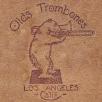
It's a bear!
Circa 1920 Bass Trombone
Bore: .530"-.545" (13.5 mm-13.8 mm), .575" (14.6 mm) attachment
Bell: 9" (228.6 mm)
I purchased this horn through eBay from a drop-shop in Lombard, Illinois, so I have no information about its history. It has no serial number, so it's difficult to date, but the engraving appears to be the same as s/n 704 depicted here). It takes a small-shank mouthpiece and came with a very battered NY Bach 3. The general consensus among the people I've shown the horn to is that the valve is an import, possibly manufactured by Cerveny. At the time this horn was built, it wouldn't have made economic sense for Olds to make their own rotors. The stockings are integral (rather than soldered on, as was common practice at the time), and the inner diameter does not increase at the stocking (the earliest one-piece Olds inners have a step in the bore at the stocking). At some point it was buffed "with extreme prejudice", so the engraving is very faint.
Some might take issue with my designating this horn as bass trombone. While it is true that a few horns of this size were being produced for use as tenor trombones (e.g., the Keefer Gardell Simons model and the early version of the Conn 8H), most people of the time would have considered it a bass trombone and its specifications are similar to the roughly contemporaneous Conn 14H Duo-Bore Medium Bass. I'm pretty comfortable calling it a bass trombone.
 Overall view |
Engraving |
Bell Patch |
One view of the valve |
Another view of the valve |
|
Braces and tuning mechanism |
Friction fit joint - no serial number |
Looking at this horn, one can't help but wonder: Who was it built for? If you'll pardon a brief excursion into rampant speculation, I have a theory...
The first question is: Who
in Los
Angeles needed a bass trombone around
1920? Well, the Los Angeles Philharmonic was founded in 1919, and an
earlier orchestra, the Los Angeles Symphony, folded soon thereafter.
The principal trombonist of the Symphony was one John Kipper "Spike"
Wallace; when the dust settled, Spike found himself playing third
trombone in the new orchestra. So - Spike probably needed a bass
trombone, and he probably needed it pretty quickly. Of course, no one
in Los Angeles would have one sitting on the shelf and ordering one
from back East would have taken some time, but there was a guy over on
24th Street who made trombones in a barn out behind his house, and his
horns were supposed to be pretty good. What makes the story even better
is that Earl Williams was probably working for Frank Olds at that time.
Could this horn have been the genesis of the Williams and Wallace
partnership? It certainly bears at least a passing resemblance to a
Williams in my collection.